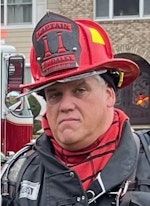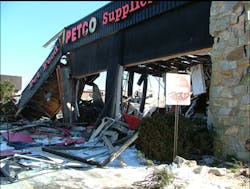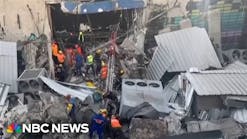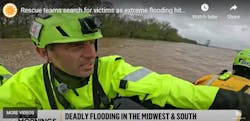Today's emergency responder will find themselves responding to a more diverse assortment of alarms. It would not be uncommon for initial responding units to find themselves "first due" to a reported structural collapse. Without proper training and preparation, these responders will find themselves inadequately prepared for this type of operation. This month, we will focus our attention on collapse planning and preparation, common safety issues, collapse assessment, and response considerations.
It is important to understand the need for thorough planning for this type of response. Structural collapses are not a normal, everyday occurrence for most responders. This alone sets up an opportunity for catastrophic injury, as rescuers are more prone to injury while performing skills that they do not use regularly, at incidents that they do not train on regularly. Most people are of the mindset that, since the potential to respond to a collapse incident in their jurisdiction is minimal at best, the need for thorough training in this category is minimal as well. In fact, the rarity of this type of event helps to confirm the need for more training in this discipline (see Photo 1). This lack of, or inadequate level of training, can be linked to a number of on-scene issues:
Failure of the Incident Command System: The dynamic intensity of the scene will overwhelm an inexperienced officer, and it is up to the incident commander (IC) to keep control of the incident. Moreover, should the collapse happen after initial units are on scene (for example: resulting from a fire), the potential of responder injury or loss will certainly create a chaotic scene for the IC.
Freelancing: A large amount of rescuers will be a necessity on scene, performing a variety of tasks, including search, air monitoring, medical triage, and fire suppression, just to name a few. With a high risk of changing conditions on-scene, it is important to stay accountable for all rescuers operating on scene (see Photo 2).
Hazardous Materials Presence: Rescuers who are operating at a collapse can become complacent of their surroundings while focusing on their tasks at hand. Collapses at occupancies with a high hazmat potential (hardware stores, plumbing supply stores, agricultural supply stores) will serve as an additional hazard as rescuers are working their way through the rubble pile.
Communication Overload: Many agencies have the capability to talk on a variety of different frequencies. The reality is that there are some agencies nationwide that cannot talk with other disciplines that are on-scene (law, fire and EMS). There has to be a plan to handle the on-scene communications. Secondly, there will be rescuers that will have to fight for air time when a frequency gets overloaded. There should be multiple channels for different operations to communicate on, but there should also be interoperability between each, so communications between rescuers can occur.
Self-converging Resources: It is not uncommon for units to self-dispatch to the "big one," especially if it is a local incident. A well planned response protocol will help to confirm the right resources will be called to the incident, when they are needed to respond. Furthermore, these incidents can run through multiple operational periods. If all of the local resources are depleted during the initial response, there will not be an ample supply for the next operational period.
Building Features
Structures are built with two primary objectives in mind: to resist gravity and resist wind shear. In his book, Building Construction for the Fire Service, Frank Brannigan wrote of the "Gravity Resistance System" that is designed into each structure. It is the combination of all of the structural elements and their connections that support the structure, and direct these forces back into the Earth (see Photo 3). This "system" is the design result that keeps the structure from failing under ordinary, everyday usage. To understand this system, a rescuer must have a solid knowledge of building construction. This is of paramount importance. This knowledge helps responders predict smoke and fire behavior; predict how the structure will behave when it is compromised; identify potential rescue problems on scene; types of construction materials that will have to be breached; heavy structural components that will have to be moved; and predict occupant and utility locations (see Photo 4).
Over the years, construction methods and techniques have changed, but what haven't changed are the laws of physics. It is imperative that firefighters have a thorough understanding of how buildings are constructed, and, more importantly, how they can collapse. Many officers have learned their decision-making process through experiences on the fireground; however, the clues that existed in the past, such as sagging floors, racking windows and doors, and smoke coming from separations in walls, may all serve to be "too little, too late." Today, buildings are built with approximately half of the materials used years ago, but are creating almost five times the potential rate of heat release, resulting in faster destruction of structural components, and quicker collapse. It is best to have a grasp on the physical aspects of construction; mainly, gravity, loads, and forces.
Gravity has been called the greatest of firefighter enemies - unforgiving, unpredictable, and always a factor for consideration. Twenty-four hours a day, seven days a week, gravity is continually exerting forces on a structure. Overall, these stresses may not be apparent, but they are still in place. Loads can be defined as a force or action that is a result of the weight all building materials, occupants, environmental effects, and movement and changes that are applied during the normal use of the structure. Some loads are simply defined, such as a Dead Load, which includes the weight of structural components and all materials attached to the structure, and Live Load, which include anything not permanently affixed to the structure, such as furnishings, occupants, and transient (temporary) materials and occupants. Some can be enviornmental, like wind loads and distributed loads of snow on a structure's roof.
Force In Relation To Building Construction
When discussing forces, it is important to define two separate concepts: stress and strain. Stress, mostly measured in pounds per-square-inch (psi) is that result from the external force that is applied to the structural component. Strain, conversely, is the actual deformation of the component when it is stressed. Strain is usually measured per inch of original length of the component. Generally, there are a few types of forces to be identified:
Compression: A squeezing, compressive force that is placed on an object, pushing both ends towards each other (for example: a loaded upright column)
Tension: A pulling force that is placed on an object, pulling both ends apart (for example: a steel cable on a suspension bridge)
Bending: A directional force placed on the end of an object, with an opposing force placed in the middle of an object (for example: a load placed on the center of a floor joist or continuous beam)
Shearing: A force tangential to the object on which it is acting upon (for example: a pair of scissors; a rivet in an I-Beam, with a downward force on the rivet)
Toqrue: A twisting or torsional force placed on a structural component (for example: a nut on a bolt)
Collapse Characteristics
It is also important that the responders are well-versed in the signs and characteristics that a collapse may occur in their jurisdiction, such as:
Age of the building: Most buildings, as a rule of thumb, have a life span of 75 to 100 years. Lack of proper maintenance will drastically reduce their life span.
Weather: Buildings that are left open to the elements will deteriorate and rot very quickly.
Improper alterations: Building owners that take shortcuts, or alter structural components without a proper knowledge of construction are inviting trouble.
Natural disasters: Hurricanes, tornadoes, and other storms can wreak havoc on a community and can lead to a large collapse response, quickly overwhelming local resources.
Construction collapses: There have been incidents where accidents on construction sites have resulted in catastrophic failures of structures (see Photo 5).
Vehicles into buildings: While most responders treat these incidents as nothing more than "nuisance" alarms, the damaged component can result in a domino effect, bringing down the rest of the structure without any warning.
Gas explosions: The routine "smell of gas" can turn deadly for responders. There have been cases across the country where firefighters have been injured and killed while investigating the source of the "smell" (see Photo 6).
Fires: The incident commander is faced with two problems at these incidents: the first problem is the access to the firefighters that may be trapped due to the collapse. The second problem is that the fire still has to be extinguished. Many departments have trained all of their resources on rescue and none on suppression, with catastrophic results.
Preparation
It would be wise for departments to perform an "Operational Capability Check" for their jurisdiction, to identify their respective collapse potential. Identifying the types of construction in the area, combined with the age of buildings and their usage will help identify high risk structures for collapse.
This check includes an inward view of the department's capabilities. Do the members possess the needed training to handle these types of emergencies? Does the department have the tools necessary to operate on-scene? Can the department handle both single-point responses (localized collapse), and multiple point responses (widespread collapse due to natural disasters, explosions, etc.)? Is there a list of outside agencies and resources that will be needed to respond to the scene, such as engineers, USAR teams, equipment suppliers, etc.? Trying to develop the resource list while developing the incident action plan is not a good idea; it puts the rescuer way behind the proactive curve (see Photo 7).
Changes in construction materials and techniques require first responders to stay current in the field of building construction. While the affects of fire on the structure are always a major concern, the gravity resistance system in a structure can be compromised without warning, and it is up to the responder to handle this issue. Next time, we will be looking at construction types and materials, some common collapse causes associated with each, and different types of collapses.
MICHAEL P. DALEY is a lieutenant and training officer with the Monroe Township, NJ, Fire District No. 3, and is an instructor with the Middlesex County Fire Academy, where he is responsible for rescue training curriculum development. Mike has an extensive background in fire service operations and holds degrees in business management and public safety administration. Mike serves as a rescue officer with the New Jersey Urban Search and Rescue Task Force 1 and is a managing member for Fire Service Performance Concepts, a consultant group that provides assistance and support to fire departments with their training programs and course development. Mike was a panelist on Radio@Firehouse on the Successful Rescue Operations in Today's Fire Service podcast. You can reach Michael by e-mail at: [email protected].

Michael Daley
MICHAEL DALEY, who is a Firehouse contributing editor, is a 37-year veteran who serves as a captain and department training officer in Monroe Township, NJ. He is a staff instructor at multiple New Jersey fire academies and is an adjunct professor in the Fire Science Program at Middlesex County College. Daley is a nationally known instructor who has presented at multiple conferences, including Firehouse Expo and Firehouse World. His education includes accreditations as a Chief Training Officer and a Fire Investigator, and he completed the Craftsman Level of education with Project Kill the Flashover. Daley is a member of the Institution of Fire Engineers and a FEMA Instructor and Rescue Officer with NJ Urban Search and Rescue Task Force 1. He operates Fire Service Performance Concepts, which is a training and research firm that delivers and develops training courses in many fire service competencies.






